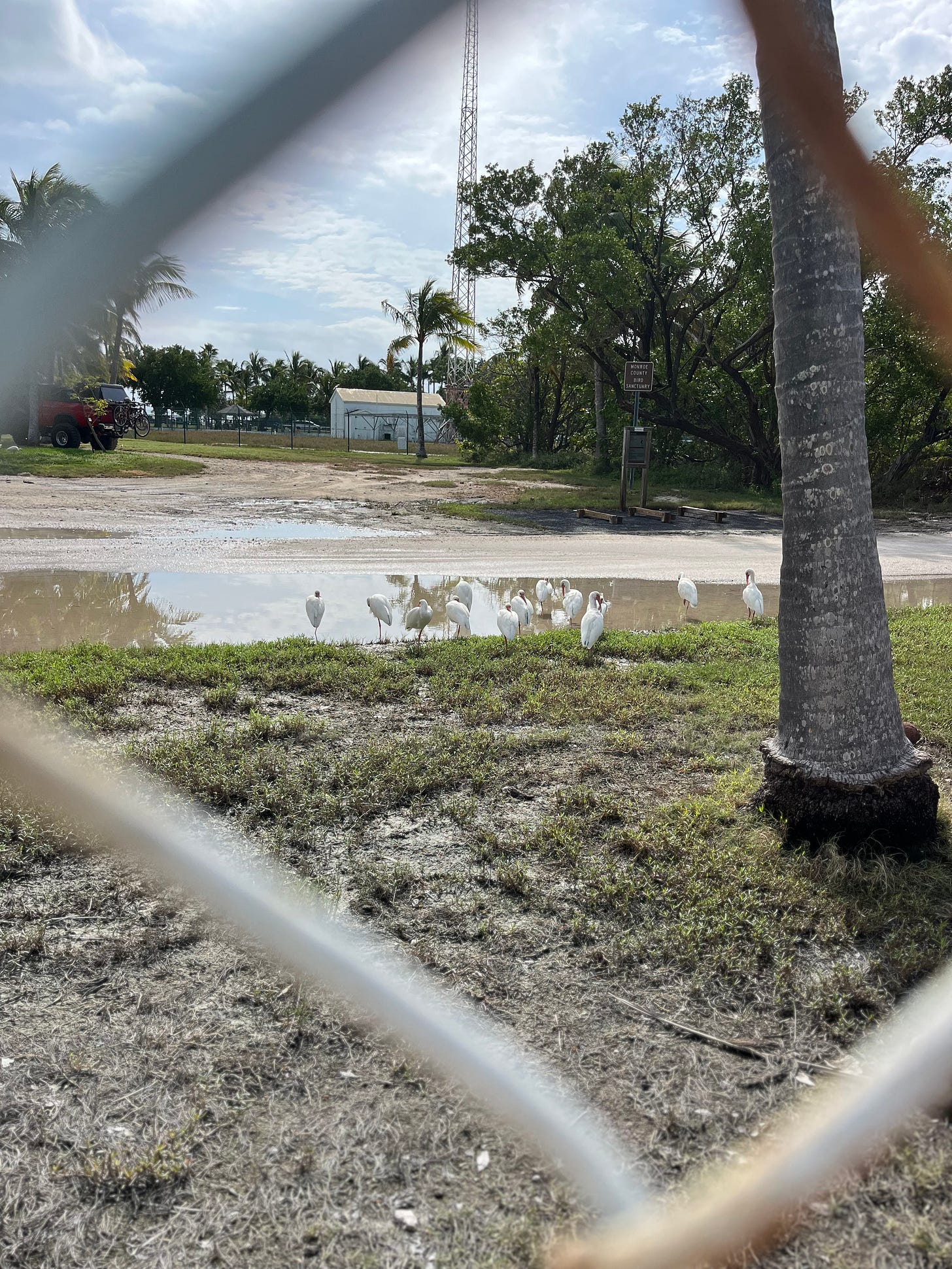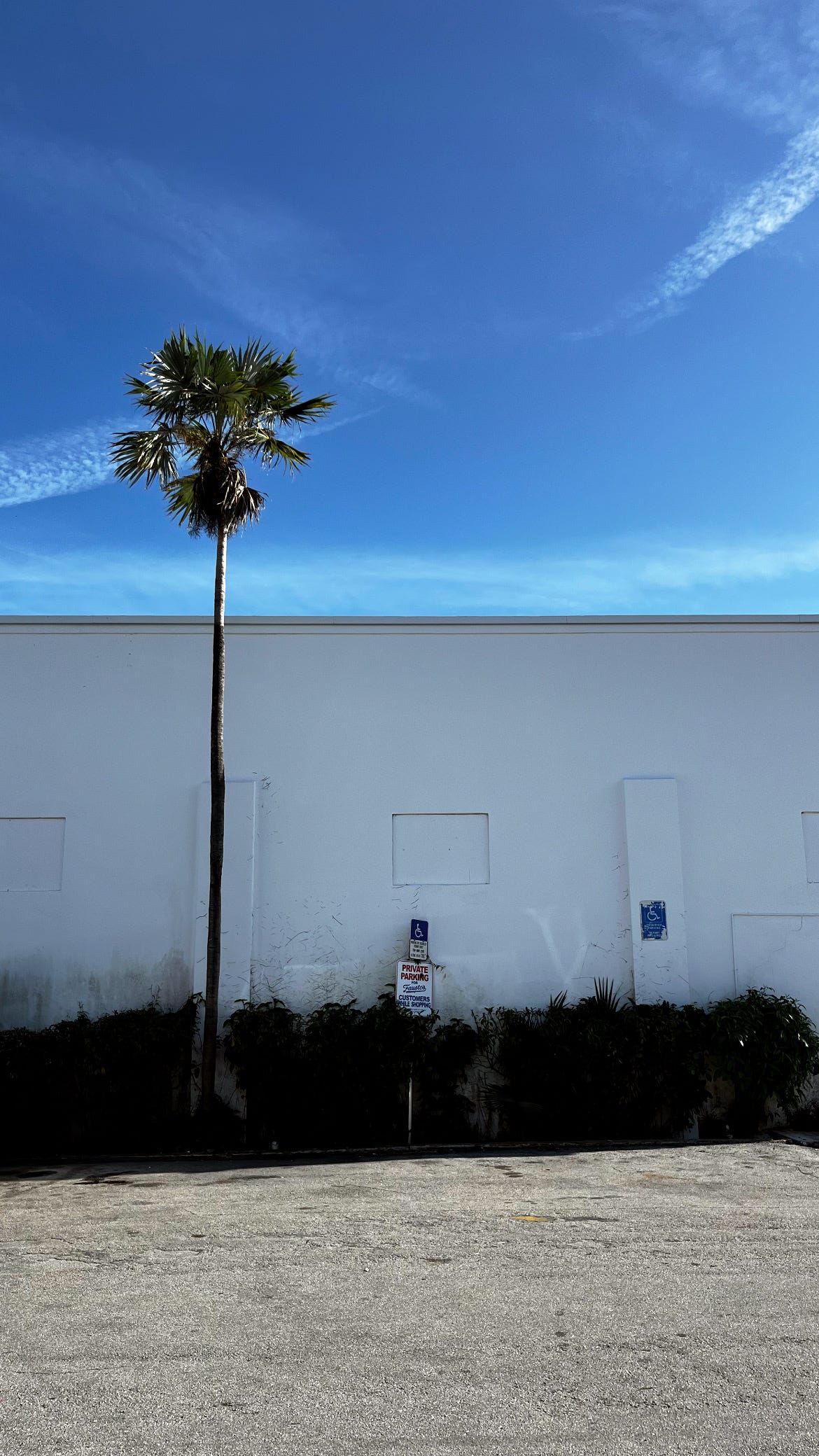Broken/the rose stem
On beautiful messes, three-month leaps, and walls that hold us in--or apart.
I toe the pram’s brake in the middle of the sidewalk, awkwardly shuffle to the side then back, side, back—c-curving my way into the street. In front of me, the wall of the corner grocery in relief of a whisked blue sky, one silver Kia, a singular, towering royal palm. I angle myself to capture the length of the store’s side—a shining light-white coherence reminiscent of the Oregon dunes, their light-white sand.
I snap one photo then re-angle to catch the wall’s breadth—snap again.
Picture taken, I kick the brake, and pram and baby and me continue on.
An amalgamation of arms, legs, and wheels, our triumvirate passes a flock of ibises concentrating near a body of poorly draining water in the dog park, a pair of roosters outrunning our footsteps, a duet of cloudless sulphurs with yellow-green wings slipping behind tired orchids, pink-red hibiscus. We pass gleaming pastel scooters of the season’s snowbirds and the old bikes of hardened locals. We pass an electric golf cart of tourists—scantily clad and well oiled—swinging recklessly around a corner, the tourists waving wildly at a jet making a midday landing—silver underbelly exposed. In our own flight path: several blue-and-yellow Conch Republic flags whipping proudly or ironically or a little of both against the island breeze.
As we near home, the wind picks up and a passing cloud relieves itself of rain. I cover the pram in its plastic shell— let the water wash around Aoife’s small body, at first tinny and frequent then heavy and diffuse. Aoife watches it all from her SnugSeat—her sun bonnet tied raggedly below her chin, her tiny eyebrows furrowed and mimicking my own scowl, her blue eyes confused—and, rightfully so. At just twelve weeks, Aoife fails to connect the springtime ballet of the butterflies or the back-and-forth wave of the flag or even the rebound of the rain.
Going through a developmental leap deemed "Smooth Transitions,” Aoife does not yet understand ‘events’—that is stringed actions, occurrences with starts, fits, ends. Her world something more fractured, fragmented—fractal:
From the butterfly—a rising yellow, a drop in shadow, a flit of fluorescence, a thing dipping down. From the tourist-filled golf cart: some skin flapped—an arm felled, a finger unflowering then another unflowering then an unconnected third. To her the flag is likely a face pulled one way in pain then a silken surface whistling through the air at another, distant time. And, when it comes to the rain, there is no smooth ricochet or eloquent bounce. One rain driving down, a different rain settling like marbles on the floor—still another rain set apart from the first.
I imagine this final rain to be like bullets slowly rising in The Matrix—the result of some unseen, algorithmic command, and, also, the world parceled into motion, sectioned by movement—seen in this way—to be exhausting.
As a thing that feels she is simultaneously coming apart, I can only commiserate.
This week for various reasons I am alone with Aoife.
I savor this time, but my anxiety becomes instinctual and all-powerful—fear keeping our footprint on the island small. Except for our neighborhood strolls with planned destinations, we hunker down—separating ourselves from everyone and everything outside. Alone with each other, we become not unlike the house in which we move—dissolving a little too readily into its walls.
Walls that—at times—seem to be the only thing holding us together, or letting us—without worry—spill out.
Inside the house, things are not unlike the world as Aoife sees it: split, slivered, scattered. On our carpet, a mess of crinkle books and teethers and lovies and burp cloths of all sizes and shapes and colors. On a low-lying table: even greater disarray. Sensory toys in egregious reds and indelicate yellows and blinding greens, ear-marked novels, a plastic cup of half-drunk coffee, a field guide of Florida’s birds, the remains of a lunch—or many lunches, half-written cards, loose-leaf instructions, a mug of tepid tea.
The living room—our makeshift command center—is where I hold Aoife, bounce Aoife, walk Aoife, and feed Aoife, all while trying to send reports.
Try.
What comes out is more like punctured telegrams, odd morse, and poorly written code.
I take to creating subject lines-as-emails with all 14 pounds of baby dangling in my arms. Each note reveals a mind like a needle stuck, rubbing the same spot of the same groove again and again. My focus: the little person on my lap or hip or chest, the immediate surroundings into which I can feel myself blur: Aoife at pool. Aoife did a full 180. Mama and Aoife. Aoife and her new teeth. Fifi the Firefly. Fifi getting eaten. Fifi going THROUGH it. Walk! What I spotted in the closet. Walk! Still convinced about the closet. Nap! See photo of closet. Cleaning out closet. Closet cleaned.
Like the notes that make their way out from our internal world, what comes in is similarly slight and misshapen—Aoife and I only getting glimmers from the world beyond:
A man in underwear running up a flight of stairs, flexing on a burnt-orange sofa, the girl world's elation.
A celebrity's face change.
A man talking brazenly about breasts in a room full of breasts.
A war. A shooting. A woman punished for miscarrying at home.
A military crackdown at or below the equator.
A genocide abroad.
A secret tunnel.
Lies about tunnels.
Proof against the lies about the tunnels.
A poorly drawn map. A hidden cemetery. A prince who is also a legend. Daycare prices rising. Food prices rising. People who can't buy food. Women who eat almonds. Women and their bodies. 20,000 bodies. 22,000 bodies. 24,000 bodies. A strip of land. A crossing of a sea. An exit. A cutting off. A wall. A wall in dispute. A dispute and then maybe(?) a wall.
As a woman in a body keeping herself and her baby to walls this week, it’s no wonder I’ve been drawn to them and their peculiarities.
Walls that protect and warm.
Walls that insulate and in insulating, isolate.
Walls that filter light and image, muffle and distort story, language, sound. Thick walls and thin walls, strong walls and weak walls. Walls like those around us holding us somehow together and then walls like those outside us that run and run and run. Smooth. Coherent, cohering, cohered. Walls I have taken to photographing across the island. Wooden and termite-eaten yet ongoing. Sided and mold-stained and unending. Walls that are unbroken in a way I think I no longer am, and worry (as a mother) I may never again be. Gray cement perpetuity, pink stuccoed forever.
And, yet, perhaps the smoothness of my once life, the gluiness of that former self has always been a fallacy.
As if by coincidence, on the day I am able to finally break away from my duty as Aoife’s sole caretaker, I take a virtual workshop where we are to discuss Dorianne Laux’s poem "What's Broken.”
The poem begins with a list of things past and present that are or have been broken (a middle step, a mother's necklace, rent), and ends with a move toward a more emotional plane—addressing the speaker’s broken heart: "my heart/a blue cup fallen from one's hands."
It is the middle of the poem, however, that gives me pause:
...Broken
the days into nights, the night sky
into stars, the stars into patterns
I make up as I trace them
with a broken-off blade
of grass...
The juxtaposition of world and speaker a reminder of the natural state of the natural world. One not of lucidity but of division, split-ness, apart-ness. Our reality—universe—earth—lives—living rooms—spilling out into a kind of beautiful mess. The shape of that mess? The form and pattern it takes? Just a trick of the eye and how we trace. The calipers we choose and the blades of fine grass we hold and the stories we tell: flits of fluorescence rewritten as long yellow-green flights, the rise and fall of wet turned softly into rain.






